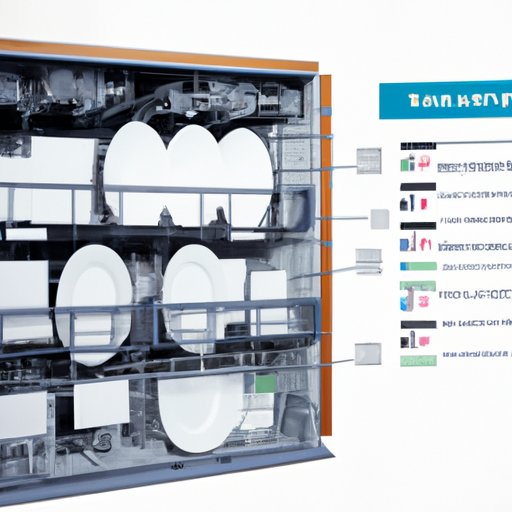
Introduction
If you don’t have a dishwasher at home, washing dishes can be a tedious and time-consuming chore. Fortunately, a dishwasher can make life a lot easier, especially if you have a large family or entertain frequently. In this article, we will provide you with a step-by-step guide on how to use a dishwasher along with other valuable information on how to maintain and extend its life.
Step-by-Step Guide
First, familiarize yourself with the different sections of the dishwasher, including the detergent dispenser, spray arm, racks, and control panel. Once you’re familiar with the dishwasher, it’s time to start loading the dishes. Make sure scraped food is removed before stacking plates, bowls, and cups into the racks. Placing large dishes at the bottom, delicate glasses in the top, and silverware in the proper basket are important for efficient cleaning. Additionally, if you are washing items of different materials or weight, it’s crucial to carefully work out the loading sequence to avoid breakages and to ensure a thorough clean.
Next, select the wash cycle that fits the requirements of your load. Most dishwashers have multiple cycles like normal, quick, heavy-duty and more. The wash duration, water usage, and energy consumption vary with each cycle, so pick the most suitable program.
Remember not to overfill the detergent dispenser, and always use the right amount of detergent. Too much detergent can cause excess suds, which can prevent your dishwasher from cleaning and rinsing effectively.
After the wash cycle is complete, the dishwasher will typically have a drying cycle. However, some dishwasher models require that you manually stop the wash cycle and then open the door.
Despite the dishwasher working efficiently, it still may encounter some troubleshooting issues. For example, if there are spots on dishes, you may need to scrub the dishes more thoroughly.
Pros and Cons of Using a Dishwasher
Owning a dishwasher comes with many benefits and drawbacks. One major advantage is that it saves time, energy, and water compared to washing dishes by hand. Dishwashers also help kill germs and bacteria that reside on dishes and utensils. On the other hand, dishwashers can be expensive, use a lot of energy, and can be harmful to the environment. Dishwashers also aren’t suitable for all types of dishware. Plastic dishes, for example, are prone to melting in dishwashers and shouldn’t be washed in them.
Maintenance and Cleaning Tips
To keep your dishwasher running smoothly, it’s important to regularly clean the interior and exterior of the appliance.
First, remove the racks and clean them with water and soap. After that, clean the interior of the appliance with a damp cloth and mild detergent. Pay special attention to the spray arm, the dishwasher’s drain, and the area around the detergent dispenser.
To prevent odors and mold build-up, make sure to leave the dishwasher door open when it’s not in use. Finally, remember to check the dishwasher’s filter regularly to ensure that it’s not clogged.
Energy-Saving Tips
One of the significant benefits of dishwashers is their energy-saving capabilities. To maximize their effectiveness, it’s important to load your dishwasher efficiently and run it only when it’s full. It’s also useful to select the correct cycle that suits the load you’re washing as energy saving features vary with different cycles on different dishwashers.
Dishwasher as an Investment
Dishwashers are a significant investment, so it’s worth evaluating your financial situation before committing to purchasing one. By utilizing the cost savings offered by efficient energy and water usage and factoring in reduced time and labor benefits, you may discover it’s well worth it, particularly for larger households.
Comparing Different Types of Dishwashers
When you decide to purchase a dishwasher, it’s essential to consider which type will work best for your specific needs. Built-in dishwashers, for example, are more permanent and are often quieter than portable machines, while portable dishwashers offer more flexibility. It’s worth doing research on different brands, models, and their features, such as quick wash cycles, filtration systems, noise level, and sensor technology. It’s an investment in relaxed living as well as saving time and water labor.
Conclusion
Using a dishwasher can be a time-saving and convenient way to clean dishes, but they need proper maintenance and care to remain working well. By following our step-by-step guide, taking note of maintenance and energy-saving tips, and considering the different options in the market, purchasing a dishwasher can be a positive investment that can impact your household positively.
Remember the key to using a dishwasher effectively is ensuring the proper loading sequence and cycle selected from the menu delivered optimum cleaning and efficiency results.





